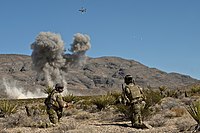
Photo from wikipedia
Species' geographic range limits are most often not demarcated by obvious dispersal barriers. Poor‐quality habitat at the edge of a species' range can prevent range expansion by preventing outward migration… Click to show full abstract
Species' geographic range limits are most often not demarcated by obvious dispersal barriers. Poor‐quality habitat at the edge of a species' range can prevent range expansion by preventing outward migration or through reducing adaptive potential resulting from decreased genetic diversity. We identified habitat variables that constrain gene flow across the entire geographic range of an endemic salamander (Ambystoma barbouri) in the eastern United States, and we tested whether increased resistance resulting from these variables provides cryptic dispersal barriers at the range edges. Using polymorphic microsatellite loci, we first identified three genetic clusters that are separated by the Ohio and Kentucky rivers. Through a combination of landscape genetic analyses and generalized dissimilarity modelling, we then classified variables that (i) restrict gene flow in each of the genetic clusters across the geographic distribution of A. barbouri and (ii) become more common towards the peripheries of the distribution. A decrease in limestone availability and an increase in growing season precipitation were correlated with high resistance to gene flow across the range, and both became more common at the edges of the species' distribution. However, other landscape variables were more important for explaining variation in geneflow rates in different portions of the range, such as increased mean annual temperature and frost‐free period in the south vs. growing season precipitation in the north. Taken together, these results suggest that there are both range‐wide and regionally specific cryptic habitat barriers preventing geographic range expansion. Species ‘geographic range limits are probably governed by a set of ecological and evolutionary factors, and our landscape genetic approach could be applied to gain additional insight into many systems.
Journal Title: Molecular Ecology
Year Published: 2017
Link to full text (if available)
Share on Social Media: Sign Up to like & get
recommendations!